We arrived in Valparaiso after a 14 hour bus journey (we lost 2 hours through a tyre problem). No matter; it was SUNNY and WARM – no more waterproofs! After a pleasant breakfast at our hostal we went out to explore the town.
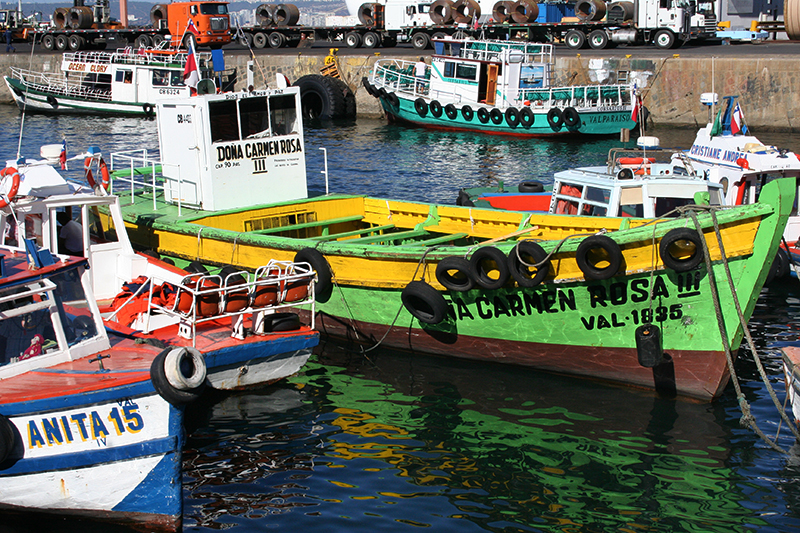 Valparaiso consists of a beautiful, natural deep water harbour guarded on all sides by hills on which the town is built. For many years it was an insignificant fishing village famous only because the pirate (as the Chileans refer to him) Frances Drake sacked it twice on his travels, stealing the gold and communion wine from the church. It became a major port when minerals were discovered in the Andes requiring somewhere to export this new wealth back to the old world. It was also the last major port before Cape Horn where ships could take on supplies and the first port of call for those who had survived that turbulent route coming west. However, once the Panama Canal opened it lost much of its trade and now it is an obligatory cruise ship port of call and the headquarters of the Chilean Navy.
Valparaiso consists of a beautiful, natural deep water harbour guarded on all sides by hills on which the town is built. For many years it was an insignificant fishing village famous only because the pirate (as the Chileans refer to him) Frances Drake sacked it twice on his travels, stealing the gold and communion wine from the church. It became a major port when minerals were discovered in the Andes requiring somewhere to export this new wealth back to the old world. It was also the last major port before Cape Horn where ships could take on supplies and the first port of call for those who had survived that turbulent route coming west. However, once the Panama Canal opened it lost much of its trade and now it is an obligatory cruise ship port of call and the headquarters of the Chilean Navy.
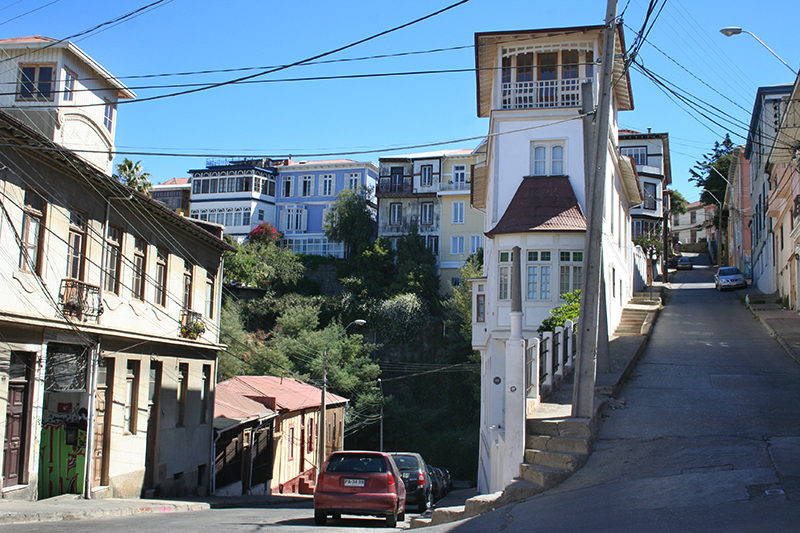 Lately, it has become a holiday satellite for the better-off residents of Santiago which has encouraged many areas of the town to smarten up but, overall, it is a bit like a penniless aristocrat retaining only traces of the architectural splendour that once set it apart from others. But it still has unique characteristics thanks to its steep terrain. There is a complete jumble of multicoloured clapboard homes and weathered Victorian mansions that cling to the sheer cliffs and unusual spaces separated by zig-zag streets that defy determined cartographers and are a town planner’s nightmare. But they serve to give the place a bohemian flair lacking in overdeveloped seaside towns. Frankly, its wonderous that any of these buildings are still standing given that the area is in an earthquake zone that suffers small tremors every few weeks as well as the occasional big one, the last of which was in 1985. The spindly little stilts that prop up many homes do not look as if they could survive a decent storm let alone an earthquake and it can only be that the fact that the hills are made from granite rock that has enabled these shelters to survive for so long.
Lately, it has become a holiday satellite for the better-off residents of Santiago which has encouraged many areas of the town to smarten up but, overall, it is a bit like a penniless aristocrat retaining only traces of the architectural splendour that once set it apart from others. But it still has unique characteristics thanks to its steep terrain. There is a complete jumble of multicoloured clapboard homes and weathered Victorian mansions that cling to the sheer cliffs and unusual spaces separated by zig-zag streets that defy determined cartographers and are a town planner’s nightmare. But they serve to give the place a bohemian flair lacking in overdeveloped seaside towns. Frankly, its wonderous that any of these buildings are still standing given that the area is in an earthquake zone that suffers small tremors every few weeks as well as the occasional big one, the last of which was in 1985. The spindly little stilts that prop up many homes do not look as if they could survive a decent storm let alone an earthquake and it can only be that the fact that the hills are made from granite rock that has enabled these shelters to survive for so long.
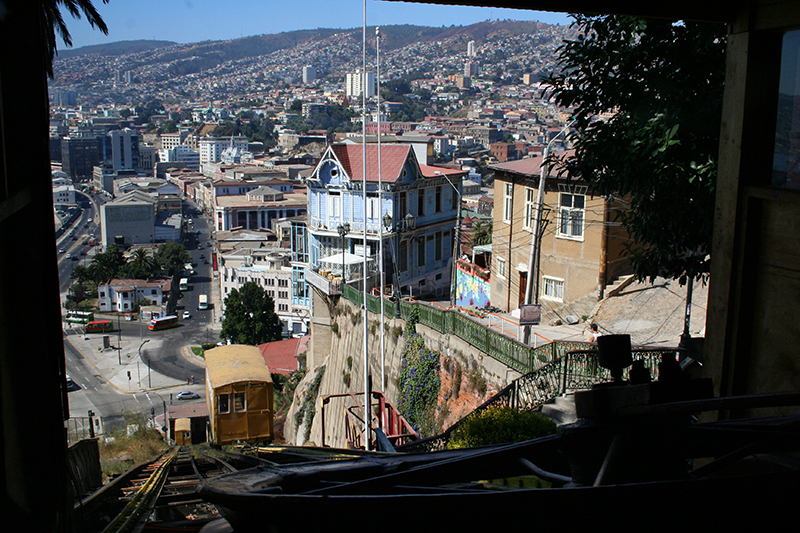 It still has its original ascensores, or funiculars, clickety clack trams that climb up some of the 42 hills of the town; we are staying on the unfashionable Cerro Artilleria (in a hostal that is rather unkindly described in the guide book as being for ‘older travelers’), our ascensore was built in 1893 and, as far as I could tell, is entirely original. The whole wooden structure creaks and groans as it is hauled up the tracks by wire rope, constantly changing shape as it negotiates bumps and hollows. It sounds and feels just like my knees.
It still has its original ascensores, or funiculars, clickety clack trams that climb up some of the 42 hills of the town; we are staying on the unfashionable Cerro Artilleria (in a hostal that is rather unkindly described in the guide book as being for ‘older travelers’), our ascensore was built in 1893 and, as far as I could tell, is entirely original. The whole wooden structure creaks and groans as it is hauled up the tracks by wire rope, constantly changing shape as it negotiates bumps and hollows. It sounds and feels just like my knees.
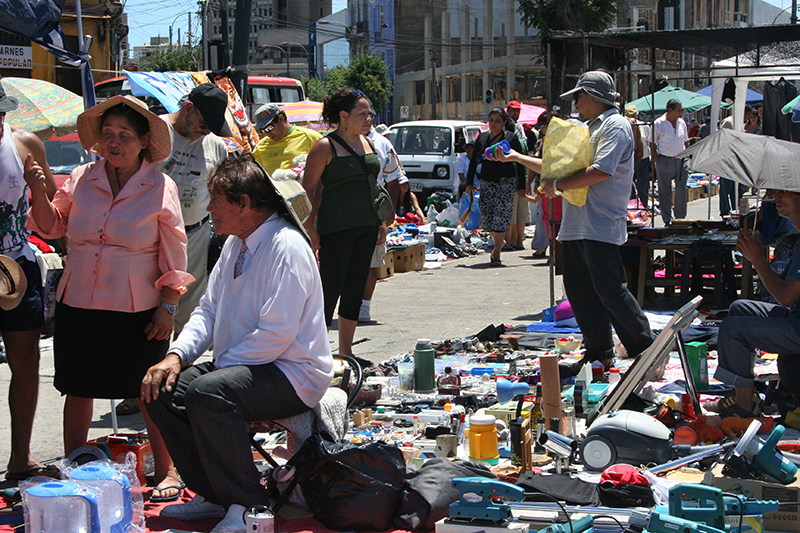 There is a large Sunday flea market that sprawls over the central reservation of the town’s widest street where it is possible to buy anything from a car axle to tissue paper. Most of the items for sale seem to be second hand and all are subject to negotiation with no guarantee implied or given; this is the place to bring the unwanted contents of any loft and it resembles a claustrophobic car boot sale.
There is a large Sunday flea market that sprawls over the central reservation of the town’s widest street where it is possible to buy anything from a car axle to tissue paper. Most of the items for sale seem to be second hand and all are subject to negotiation with no guarantee implied or given; this is the place to bring the unwanted contents of any loft and it resembles a claustrophobic car boot sale.
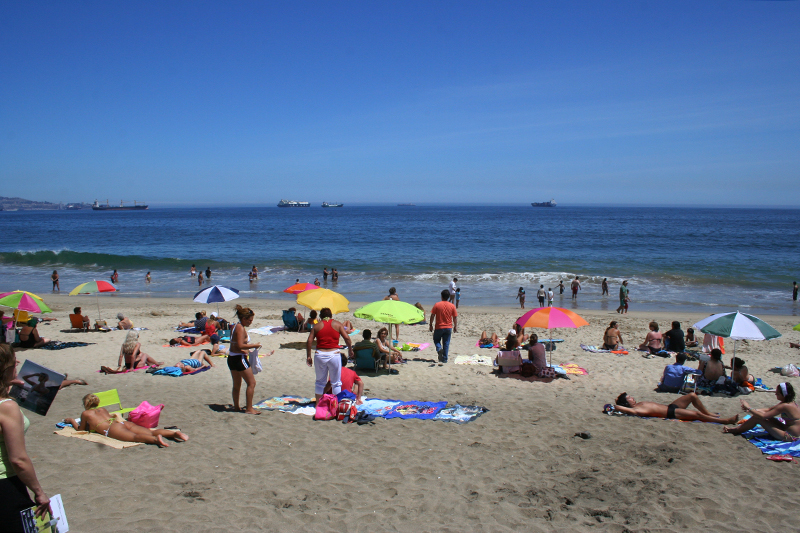 We took the opportunity to visit Vina del Mar supposedly the next village along the coast but, to a visitor, just another neighbourhood as the two places are separated only by a railway line. Vina, as us travelers like to call it, is upmarket, full of expensive apartments and holiday homes of wealthy Chileans that has become the country’s most fashionable beach resort. The geometric streets lined with palm trees, the manicured lawns, modern buildings and sanitized boardwalks are a complete contrast to the ramshackle streets of Valparaiso. We refrained from dipping our toes into the Pacific Ocean here as the Humboldt Current that runs the length of Chile makes for cold swimming conditions and only the very young or the very drunk would immerse themselves into the icy seas.
We took the opportunity to visit Vina del Mar supposedly the next village along the coast but, to a visitor, just another neighbourhood as the two places are separated only by a railway line. Vina, as us travelers like to call it, is upmarket, full of expensive apartments and holiday homes of wealthy Chileans that has become the country’s most fashionable beach resort. The geometric streets lined with palm trees, the manicured lawns, modern buildings and sanitized boardwalks are a complete contrast to the ramshackle streets of Valparaiso. We refrained from dipping our toes into the Pacific Ocean here as the Humboldt Current that runs the length of Chile makes for cold swimming conditions and only the very young or the very drunk would immerse themselves into the icy seas.
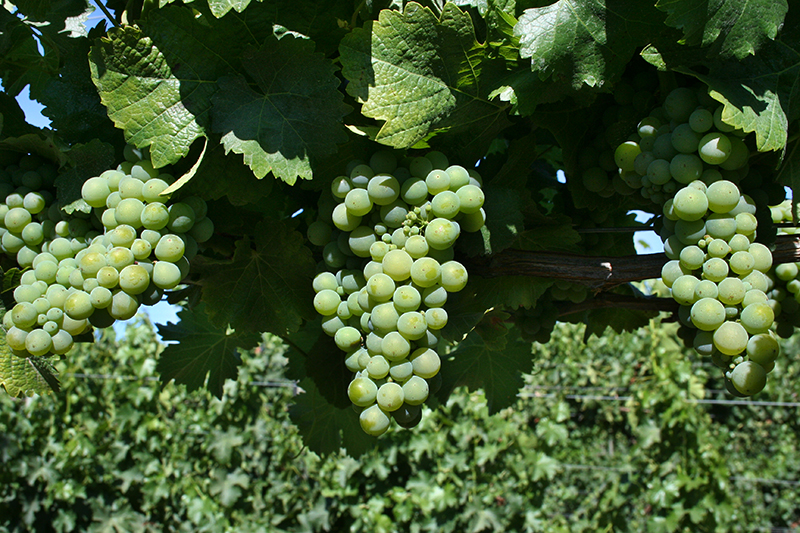 Valparaiso is also next door to the Casablanca Valley, home to Chile’s burgeoning wine industry and an area that produces sauvignon blanc, Debbie’s favourite tipple, so a visit was inevitable and a driver a sensible addition in case I had to carry my wife home afterwards. The Chileans are rather proud of their wine industry however, the more successful vineyards are run by foreigners and the Chileans themselves do not appreciate the attraction of fine wines so most of the production is exported.
Valparaiso is also next door to the Casablanca Valley, home to Chile’s burgeoning wine industry and an area that produces sauvignon blanc, Debbie’s favourite tipple, so a visit was inevitable and a driver a sensible addition in case I had to carry my wife home afterwards. The Chileans are rather proud of their wine industry however, the more successful vineyards are run by foreigners and the Chileans themselves do not appreciate the attraction of fine wines so most of the production is exported.
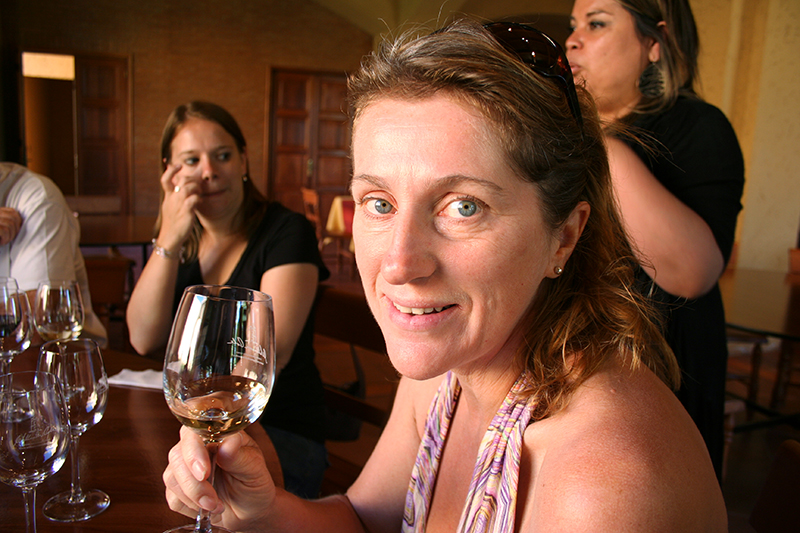 We visited a vineyard owned and run by William Cole, a Californian engineer turned winemaker. It was very much geared up for optimal production rather than quality product but, nonetheless, made a sauvignon blanc that Madam declared ‘very drinkable’. So much so that she bought a bottle to polish off later. The red wine was not quite so brilliant being comparable to a Welsh claret and made from the carmenere grape that has long since been discarded by the great European vintners. The nice, jovial lady who guided us around the production facility was refreshingly honest about the difficulties and practicalities of making wine in Chile in contrast to the usual sales talk we have received from any other winery we have visited around the globe. Perhaps because the wine was cheap and therefore did not need to be hyped: the price is the sales pitch.
We visited a vineyard owned and run by William Cole, a Californian engineer turned winemaker. It was very much geared up for optimal production rather than quality product but, nonetheless, made a sauvignon blanc that Madam declared ‘very drinkable’. So much so that she bought a bottle to polish off later. The red wine was not quite so brilliant being comparable to a Welsh claret and made from the carmenere grape that has long since been discarded by the great European vintners. The nice, jovial lady who guided us around the production facility was refreshingly honest about the difficulties and practicalities of making wine in Chile in contrast to the usual sales talk we have received from any other winery we have visited around the globe. Perhaps because the wine was cheap and therefore did not need to be hyped: the price is the sales pitch.
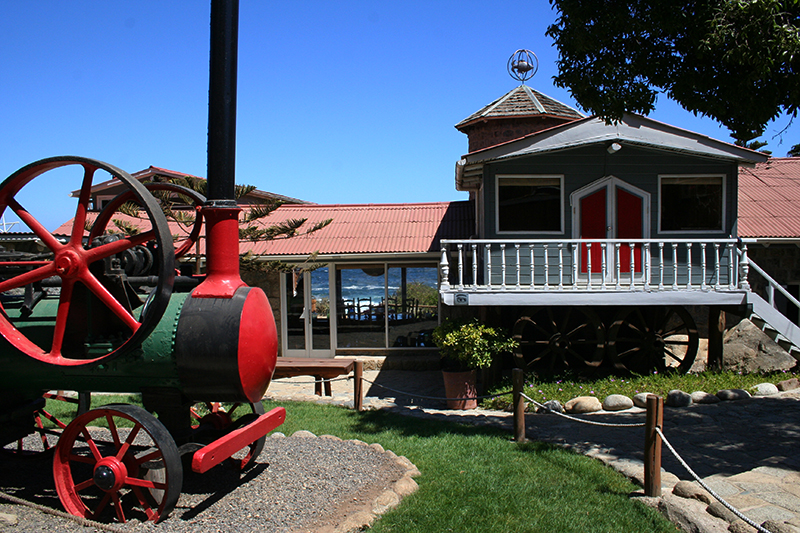 On the way back, we stopped off at Isla Negra, the home of Chile’s most celebrated poet, Pablo Neruda. As any well-read student would know, he won the Nobel Prize for Literature in 1971, the second of only two South Americans to have been awarded the honour and both from the same country!
On the way back, we stopped off at Isla Negra, the home of Chile’s most celebrated poet, Pablo Neruda. As any well-read student would know, he won the Nobel Prize for Literature in 1971, the second of only two South Americans to have been awarded the honour and both from the same country!
Anyway, I could not pass up the opportunity to visit the home of a fellow poet and scholar especially one who had called his place Isla Negra when it was plainly part of the mainland and not in any normal person’s reckoning an island at all. Pablo’s mind, like all of us great writers, stretched the boundaries of imagination and senses and to many people his writing is not poetry at all but just a bunch of short lines that do not scan or develop thought. What philistines! The only reason poor Pablo is not already world famous is that he wrote his poetry in Spanish. How difficult is that?
His house is perched high above the sand and sea that inspired him and is now a museum. It is the most fabulous spot with spectacular views to the wild ocean that are enough to stop any ordinary being from working. Here he not only produced his best work here but also entertained leagues of friends and many women. Some say that the number of ‘love interests’ he had were a necessary part of the creative process but, we all know, that one woman is enough for any man. Amazingly, during a time when divorce was not possible in Chile, he had three wives, managing to get his first two marriages annulled. How clever is that?
The interior of his house reflects his compulsive collecting, the most striking pieces being figurines from the bows of old ships, that make the whole place resemble a very attractive jumble store (a la Steptoe and Son) and is an interior designer’s nightmare. Over the years he extended and extended so there is no flow to the place but much of it is magnetically attractive: the ‘new’ master bedroom with full-length windows overlooking the sea, the ‘new’ fireplace made and adorned with enormous lumps of lapis lazuli and quartz, the ‘old’ living room with its collection of ships’ figurines. The whole house was a mess but completely mesmerizing and truly inspirational. Had it been for sale Debbie would have bought it on the spot no matter what the price. I could then fulfil my true vocation as a poet and win the Nobel Prize.
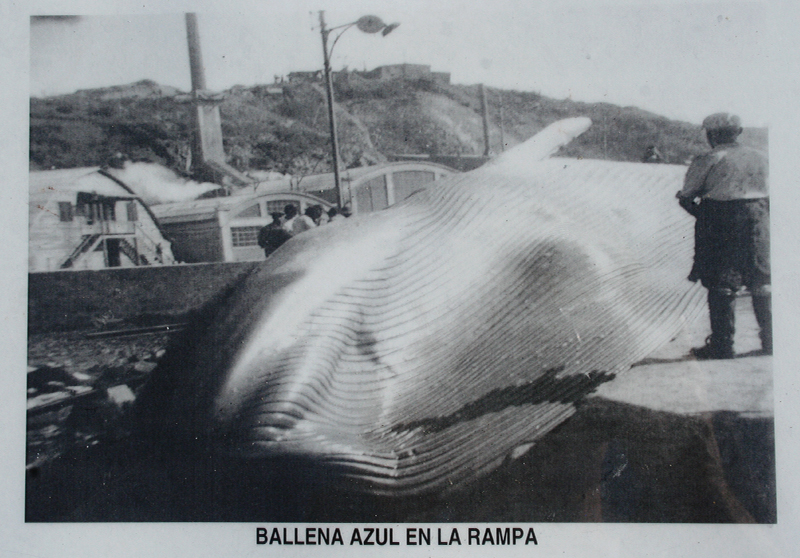 Going back to Valparaiso, we took the undulating coast road and came across a former whaling station called Quintay. It is a most beautiful little cove where the most savage butchering of the ocean’s noblest creatures took place. Most of the whaling station has now disappeared and been replaced by a university research unit specializing in pioneering farming of oceanic crustacean, but old photographs dotted around together with the ramp where the lifeless corpses of the world’s largest mammals were dragged ashore serve as a reminder of the most unpleasant industry and smells that used to reside here.
Going back to Valparaiso, we took the undulating coast road and came across a former whaling station called Quintay. It is a most beautiful little cove where the most savage butchering of the ocean’s noblest creatures took place. Most of the whaling station has now disappeared and been replaced by a university research unit specializing in pioneering farming of oceanic crustacean, but old photographs dotted around together with the ramp where the lifeless corpses of the world’s largest mammals were dragged ashore serve as a reminder of the most unpleasant industry and smells that used to reside here.
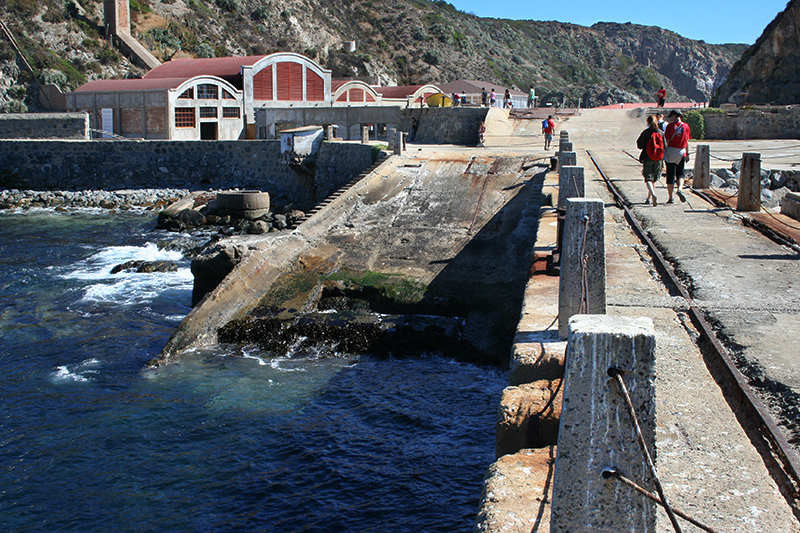 Nowadays, the fishing is on a very much smaller scale, the little cove being home to half a dozen small, open boats that together with a couple of restaurants is the lifeblood of the community. The small beach is covered by the bodies of visitors, day trippers mostly, who have come to enjoy the beauty and tranquility of this remote village.
Nowadays, the fishing is on a very much smaller scale, the little cove being home to half a dozen small, open boats that together with a couple of restaurants is the lifeblood of the community. The small beach is covered by the bodies of visitors, day trippers mostly, who have come to enjoy the beauty and tranquility of this remote village.
Our last morning in Valparaiso was spoilt by fog that had rolled in overnight and refused to evaporate. It clung on with tenacity all day, fighting off the attempts of the sun and the curses of the population with considerable success. Apparently, we were unlucky with the weather. So we went down to the port to take luncheon.
What better place to spend time than a port! Valparaiso port is a contrast of formality (the navy), highly organized industry (the container port), slightly slapdash loading (the fruit and veg refrigerated port) and the totally chaotic (the tourist tripper boats). Any one of these can hold our attention between lunchtime chatter, but with all of them within a sweep of the eye, the talking was often done while looking elsewhere. Particularly the tourist boats who were fighting each other for a place in the queue for passengers and each of whom had touts on land fighting each other to entice the trippers on to their particular boat. I was hoping for a proper fight but was disappointed. But what happy entertainment!
Afterwards, we sloped off to the bus terminal and jumped on the first vehicle going to Santiago where we are stopping off on our way to Rio for the carnival. I was getting so excited I could not sit still.

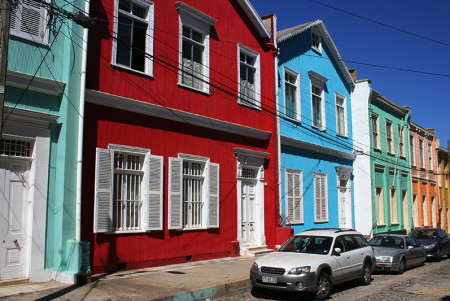
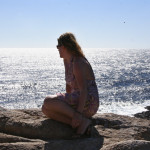
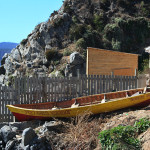
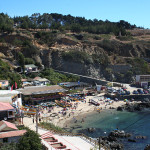
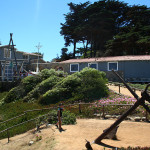
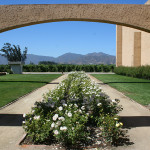
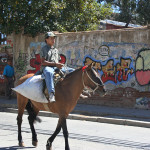
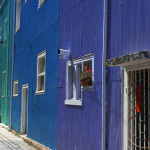
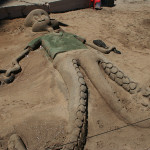
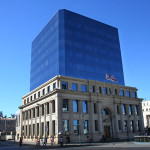
No comments yet.